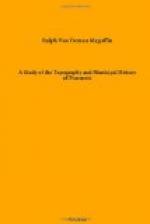Also as to the shape of the upper temple and the number of steps to it, we have certain facts from a document from the archives of the Vatican, published in Petrini, l.c., p. 429; palacii nobilissimi et antiquissimi scalae de nobilissimo marmore per quas etiam equitando ascendi poterat in Palacium ... quaequidem scalae erant ultra centum numero. Palacium autem Caesaris aedificatum ad modum unius C propter primam litteram nominis sui, et templum palatio inhaerens, opere sumptuosissimo et nobilissimo aedificatum ad modum s. Mariae rotundae de urbe.]
[Footnote 102: Delbrueck, Hellenistische Bauten in Latium, under Das Heiligtum der Fortuna in Praeneste, p. 47 ff.]
[Footnote 103: Cicero, De Div., II, 41, 85.]
[Footnote 104: Marucchi wishes to make the east cave the older and the real cave of the sortes. However, he does not know the two best arguments for his case; Lampridius, Alex. Severus, XVIII, 4, 6 (Peter); Huic sors in templo Praenestinae talis extitit, and Suetonius Tib., 63: non repperisset in arca nisi relata rursus ad templum. Topography is all with the cave on the west, Marucchi is wrong, although he makes a very good case (Bull. Com., 32 (1904), p. 239).]
[Footnote 105: Cicero, de Div., II, 41, 85: is est hodie locus saeptus religiose propter Iovis pueri, qui lactens cum lunone Fortunae in gremio sedens, ... eodemque tempore in eo loco, ubi Fortunae nunc est aedes, etc.]
[Footnote 106: C.I.L., XIV, 2867: ...ut Triviam in Iunonario, ut in pronao aedis statuam, etc., and Livy, XXIII, 19, 18 of 216 B.C.: Idem titulus (a laudatory inscription to M. Anicius) tribus signis in aede Fortunae positis fuit subiectus.]
[Footnote 107: This question is not topographical and can not be discussed at any length here. But the best solution seems to be that Fortuna as child of Jupiter (Diovo filea primocenia, C.I.L., XIV., 2863, Iovis puer primigenia, C.I.L., XIV, 2862, 2863) was confounded with her name Iovis puer, and another cult tradition which made Fortuna mother of two children. As the Roman deity Jupiter grew in importance, the tendency was for the Romans to misunderstand Iovis puer as the boy god Jupiter, as they really did (Wissowa, Relig. u. Kult. d. Roemer, p. 209), and the pride of the Praenestines then made Fortuna the mother of Jupiter and Juno, and considered Primigenia to mean “first born,” not “first born of Jupiter.”]
[Footnote 108: The establishment of the present Cathedral of S. Agapito as the basilica of ancient Praeneste is due to the acumen of Marucchi, who has made it certain in his writings on the subject. Bull. dell’ Inst., 1881, p. 248 ff., 1882, p. 244 ff.; Guida Archeologica, 1885, p. 47 ff.; Bull. Com., 1895, p. 26 ff., 1904, p. 233 ff.]
[Footnote 109: There are 16 descriptions and plans of the temple. A full bibliography of them is in Delbrueck, Hellenistische Bauten in Latium, pp. 51-52.]




